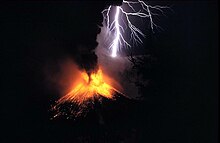Volcanic lightning
| Volcanic lightning | |
|---|---|
January 2020 eruption of Taal Volcano | |
| Effect | Lightning |
| Part of a series on |
| Weather |
|---|
|
|
Volcanic lightning is an electrical discharge caused by a
The earliest recorded observations of volcanic lightning
Instances have been reported above Alaska's
Charging mechanisms
Ice charging

Ice charging is thought to play an important role in certain types of eruption plumes – particularly those rising above the
Frictional charging
Triboelectric (frictional) charging within the plume of a volcano during eruption is thought to be a major electrical charging mechanism. Electrical charges are generated when rock fragments, ash, and ice particles in a volcanic plume collide and produce static charges, similar to the way that ice particles collide in regular thunderstorms.[12] The convective activity causing the plume to rise then separates the different charge regions, ultimately causing electrical breakdown.
Fractoemission
Fractoemission is the generation of charge through break-up of rock particles. It may be a significant source of charge near the erupting vent.[31]
Radioactive charging
Although it is thought to have a small effect on the overall charging of volcanic plumes, naturally occurring
Plume height
The height of the ash plume appears to be linked with the mechanism which generates the lightning. In taller ash plumes (7–12 km) large concentrations of water vapor may contribute to lightning activity, while smaller ash plumes (1–4 km) appear to gain more of their electric charge from fragmentation of rocks near the vent of the volcano (fractoemission).[30] The atmospheric temperature also plays a role in the formation of lightning. Colder ambient temperatures promote freezing and ice charging inside the plume, thus leading to more electrical activity.[35][33]
Lightning-induced volcanic spherules
Experimental studies and investigation of volcanic deposits have shown that volcanic lighting creates a by-product known as "lightning-induced
References
- ^ Fritz, Angela (2016). "Scientists think they've solved the mystery of how volcanic lightning forms". The Washington Post.
- ^ Mulvaney, Kieran (2016). "Mystery of Volcano Lightning Explained". Seeker.
- ^ Lipuma, Lauren (2016). "New studies uncover mysterious processes that generate volcanic lightning". American Geophysical Union GeoSpace Blog.
- S2CID 92549298.
- ISSN 1748-9326.
- ^ .
- ^ PMID 26235052.
- ^ Williams, Earl R.; McNutt, Stephen R. (2005). "Total water contents in volcanic eruption clouds and implications for electrification and lightning" (PDF). Proceedings of the 2nd International Conference on Volcanic Ash and Aviation Safety: 67–71.
- ^ ISSN 0094-8276.
- ISSN 1943-2682.
- ISSN 0094-8276.
- ^ S2CID 53140261.
- ^ a b "History of Volcanic Lightning | Volcano World | Oregon State University". volcano.oregonstate.edu. 27 May 2010. Retrieved 2018-05-09.
- ^ Perrone, Alessio. "A Defiant Volcanologist Survived 5 Eruptions while Living on Mount Vesuvius". Scientific American. Springer Nature. Retrieved 19 April 2024.
- ^ Handwerk, Brian (February 22, 2007). "Volcanic Lightning Sparked by "Dirty Thunderstorms"". National Geographic. Archived from the original on February 25, 2007. Retrieved 2009-01-09.
- ^ "Iceland Volcano Pictures: Lightning Adds Flash to Ash". National Geographic. April 19, 2010. Archived from the original on April 21, 2010. Retrieved 2010-04-20.
- ^ Sample, Ian (3 December 2015). "Sky lights up over Sicily as Mount Etna's Voragine crater erupts". The Guardian. Retrieved 2015-12-03.
- ^ DI SANTOLO, ALESSANDRA SCOTTO. "Philippines volcano eruption: Terrifying video of Taal volcano producing lightning strikes". Retrieved 12 January 2020.
- ^ Borbon, Christian. "Philippines: Volcano near Manila spews giant ash column". Gulf News. Retrieved 12 January 2020.
- ^ "Gunung Ruang Kembali Erupsi, Warga Diimbau Mengungsi". CNN Indonesia. Retrieved 17 April 2024.
- ^ ISSN 0148-0227.
- .
- ISSN 0148-0227.
- ISSN 0148-0227.
- ISBN 9780123859389
- ISBN 9780123859389
- S2CID 59522391– via Research Gate.
- ISSN 0148-0227.
- Bibcode:2013EGUGA..15.4797A.
- ^ S2CID 59522391 – via Research Gate.[clarification needed]
- ISSN 2156-2202.
- ^ a b Alpin, Karen; et al. (2014). "Electronic Charging of Volcanic Ash" (PDF). Electrostatics.org. Retrieved May 8, 2018.
- ^ ISBN 9780081004050
- .
- .
- ^ ISSN 1943-2682.
- ^ a b Perkins, Sid (March 4, 2015). "Flash glass: Lightning inside volcanic ash plumes create glassy spherules". American Association for the Advancement of Science.
- PMID 29138444.
